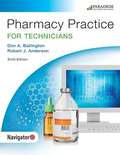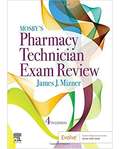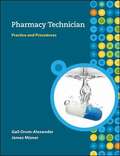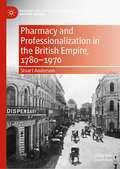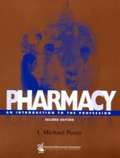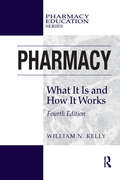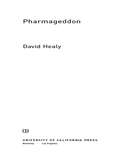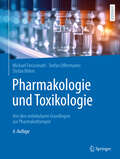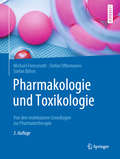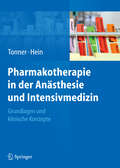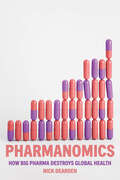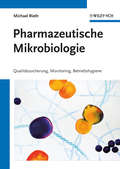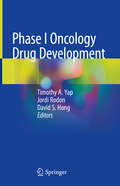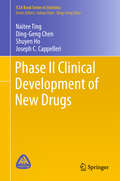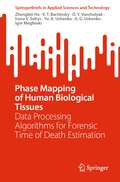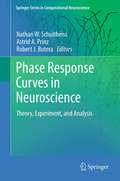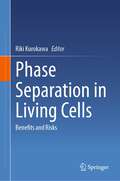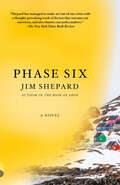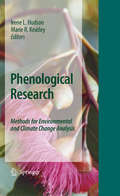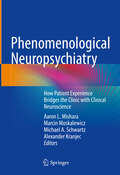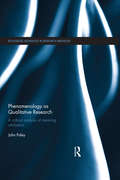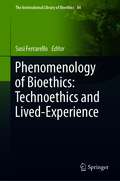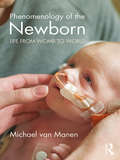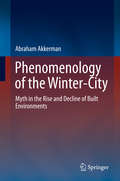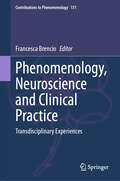- Table View
- List View
Pharmacy Practice for Technicians (Sixth Edition)
by Robert J. Anderson Don A. BallingtonProvides comprehensive coverage of pharmacy technician practice, along with coverage of business operations in a community pharmacy, professionalism and ethics in the workplace, and pharmacy careers. This text also offers insight on pharmacology, e-prescribing, pharmacy automation systems, medication safety initiatives, innovative drug delivery systems, and medication therapy management services.
Pharmacy Technician Certification Examination
by James J. MiznerPrepare for success on your certification exam! Mosby's Pharmacy Technician Exam Review, 4th Edition provides a complete review of core knowledge, thousands of review questions, and nine practice exams – plus a custom online engine that allows for unlimited opportunities to practice specific topics or create unique simulated exams. A bulleted, outline format makes review easier, reinforcing understanding with full-color illustrations, photographs, and summary tables. All questions reflect the latest exam blueprints. This resource provides you comprehensive support every step of the way for entry-level or sterile compounding certification.
Pharmacy Technician: Practice and Procedures
by Gail Orum-Alexander James J. MiznerThe book is intended for entry-level students as well as seasoned learners who want to prepare themselves for the pharmacy technician profession.
Pharmacy and Professionalization in the British Empire, 1780–1970 (Medicine and Biomedical Sciences in Modern History)
by Stuart AndersonOffering a valuable resource for medical and other historians, this book explores the processes by which pharmacy in Britain and its colonies separated from medicine and made the transition from trade to profession during the nineteenth and twentieth centuries. When the Pharmaceutical Society of Great Britain was founded in 1841, its founders considered pharmacy to be a branch of medicine. However, the 1852 Pharmacy Act made the exclusion of pharmacists from the medical profession inevitable, and in 1864 the General Medical Council decided that pharmacy legislation was best left to pharmacists themselves. Yet across the Empire, pharmacy struggled to establish itself as an autonomous profession, with doctors in many colonies reluctant to surrender control over pharmacy. In this book the author traces the professionalization of pharmacy by exploring issues including collective action by pharmacists, the role of the state, the passage of legislation, the extension of education, and its separation from medicine. The author considers the extent to which the British model of pharmacy shaped pharmacy in the Empire, exploring the situation in the Divisions of Empire where the 1914 British Pharmacopoeia applied: Canada, the West Indies, the Mediterranean colonies, the colonies in West and South Africa, India and the Eastern colonies, Australia, New Zealand, and the Western Pacific Islands. This insightful and wide-ranging book offers a unique history of British pharmaceutical policy and practice within the colonial world, and provides a firm foundation for further studies in this under-researched aspect of the history of medicine.
Pharmacy: An Introduction to the Profession
by L. Michael PoseyAs editorial director of the APA, Posey updates his 2003 textbook introducing not the technical aspects of pharmacy, but the nature of the profession itself. It supplies core knowledge needed to put information from other courses into perspective, and is best supplements with lectures from pharmacy faculty or administrators. Revisions are based on student and instructor feedback, as well as changes in the profession and recent publications. American Pharmacists Association books are distributed by McGraw-Hill. Annotation ©2009 Book News, Inc., Portland, OR (booknews.com)
Pharmacy: What It Is and How It Works (Pharmacy Education Series)
by William N. KellyNow fully updated for its fourth edition, Pharmacy: What It Is and How It Works continues to provide a comprehensive review of all aspects of pharmacy, from the various roles, pathways and settings of pharmacists to information about how pharmacy works within the broader health care system. Beginning with a brief historical perspective on the field, the book discusses the many facets of the pharmacy profession. It describes the role of pharmacists in different settings and provides information ranging from licensing requirements to working conditions, highlighting the critical role of pharmacists within the health care system. The author examines the drug use process with sections on distribution, prescribing, dispensing, and pricing. He also discusses the role of pharmacy support personnel. A chapter on informatics explores how pharmacy has evolved through information technology and automation. Additional chapters cover poison control, pharmaceutical care, pharmacy organizations, the drug approval process, and career development. Designed for classroom and professional use, the book contains numerous tools to facilitate comprehension, including: Learning objectives to help readers focus on the goals of each chapter Informative tables and figures summarizing data Summary paragraphs tying in salient points Discussion questions and exercises to test assimilation "Challenges" which place the material in broader context Websites and references to encourage further study This valuable text provides a look into the profession that is both broad and deep, supplying a one-stop introduction to a promising career in pharmacy.
Pharmageddon
by David HealyThis searing indictment, David Healy's most comprehensive and forceful argument against the pharmaceuticalization of medicine, tackles problems in health care that are leading to a growing number of deaths and disabilities. Healy, who was the first to draw attention to the now well-publicized suicide-inducing side effects of many anti-depressants, attributes our current state of affairs to three key factors: product rather than process patents on drugs, the classification of certain drugs as prescription-only, and industry-controlled drug trials. These developments have tied the survival of pharmaceutical companies to the development of blockbuster drugs, so that they must overhype benefits and deny real hazards. Healy further explains why these trends have basically ended the possibility of universal health care in the United States and elsewhere around the world. He concludes with suggestions for reform of our currently corrupted evidence-based medical system.
Pharmakologie und Toxikologie: Von den molekularen Grundlagen zur Pharmakotherapie
by Stefan Offermanns Michael Freissmuth Stefan BöhmIhr Wegweiser durch die Welt der ArzneimittelWas machen Betablocker? Wie beeinflussen Wirkstoffe unseren Hormonhaushalt? Und wie kann ich mir die vielen Antibiotika merken?In diesem Buch werden alle wichtigen Arzneimittel, gegliedert nach Organsystemen, umfassend dargestellt. Dabei wird in jedem Kapitel neben Wirkmechanismus, Kinetik, unerwünschten Wirkungen, Interaktionen und Indikationen auch die Pharmakotherapie beschrieben. Die allgemeinen und die molekularen Grundlagen werden ausführlich erklärt und helfen, Wirkmechanismen besser zu verstehen. Um die große Menge an Lernstoff besser bewältigen zu können, gibt es ein durchdachtes didaktisches Konzept:• Arzneimittel-Steckbriefe für den schnellen Überblick• Lernziele am Kapitelanfang• Fallbeispiele für die Praxis• Cave- und Merksätze für die wichtigsten Fakten
Pharmakologie und Toxikologie: Von den molekularen Grundlagen zur Pharmakotherapie (Springer-lehrbuch Ser.)
by Stefan Offermanns Michael Freissmuth Stefan BöhmIn diesem Buch werden alle wichtigen Arzneimittel, gegliedert nach Organsystemen, umfassend dargestellt. Dabei wird in jedem Kapitel neben Wirkmechanismus, Kinetik, unerwünschten Wirkungen, Interaktionen und Indikationen auch die Pharmakotherapie beschrieben. Die allgemeinen und die molekularen Grundlagen werden ausführlich erklärt und helfen, Wirkmechanismen besser zu verstehen. Um die große Menge an Lernstoff besser bewältigen zu können, gibt es ein durchdachtes didaktisches Konzept:• Arzneimittel-Steckbriefe für den schnellen Überblick• Lernziele am Kapitelanfang• Fallbeispiele für die Praxis• Cave- und Merksätze für die wichtigsten Fakten
Pharmakotherapie in der Anästhesie und Intensivmedizin
by Lutz Hein Peter H. TonnerKenntnisse der Pharmakologie und zu deren Anwendung gehören zum notwendigen Rüstzeug für Anästhesisten und Intensivmediziner. In dem Band erläutern erfahrene Anästhesisten und Pharmakologen die pharmakologischen Grundlagen und die Anwendung von Medikamenten, die in Anästhesie und Intensivmedizin eingesetzt werden. Systematisch und verbunden mit klinischen Konzepten und Anwendungshinweisen stellen die Autoren chemische Struktur, Wirkungsweise, Nebenwirkungen sowie Indikationen dar. Antibiotika und deren Anwendung ist ein eigenes Kapitel gewidmet.
Pharmanomics: How Big Pharma Destroys Global Health
by Nick DeardenInvestigative journalist Nick Dearden digs down into the way we produce our medicines and finds that Big Pharma is failing us, with catastrophic consequences.Big Pharma is more interested in profit than health. This was made clear as governments rushed to produce vaccines during the Covid pandemic. Behind the much-trumpeted scientific breakthroughs, major companies found new ways of gouging billions from governments in the West while abandoning the Global South. But this is only the latest episode in a long history of financialising medicine—from Purdue&’s rapacious marketing of highly addictive OxyContin through Martin Shkreli&’s hiking the price of a lifesaving drug to the 4.5 million South Africans needlessly deprived of HIV/AIDS medication. Since the 1990s, Big Pharma has gone out of its way to protect its property through the patent system. As a result, the business has focused not on researching new medicines but on building monopolies. This system has helped restructure our economy away from invention and production in order to benefit financial markets. It has fundamentally reshaped the relationship between richer and poorer countries, as the access to new medicines and the permission to manufacture them is ruthlessly policed. In response, Dearden offers a pathway to a fairer, safer system for all.
Pharmazeutische Mikrobiologie: Qualitätssicherung, Monitoring, Betriebshygiene
by Michael RiethDie pharmazeutische Mikrobiologie hat sich in den letzten Jahrzehnten von einer hochspezialisierten Wissenschaft zu einer Querschnittdisziplin entwickelt, die fur Pharmazeuten, Mikrobiologen, aber auch Mediziner und Qualitatssicherungsbeauftragte von fundamentaler Bedeutung ist. Michael Rieth, promovierter Mikrobiologe mit langjahriger Erfahrung in mikrobiologischer Qualitatsprufung in der pharmazeutischen Industrie, stellt in diesem Buch umfassend alle unterschiedlichen Aktivitaten, Entwicklungen und Technologien dieses dynamischen Gebiets zusammen. Immer aus dem Blickwinkel der pharmazeutischen Praxis, liegt hier das erste deutschsprachige Buch vor, das den wachsenden Anforderungen an Arzneimittelsicherheit und -qualitat Rechnung tragt und selbstverstandlich Erfordernisse nationaler und internationaler (FDA) Kontroll- und Regulierungsbehorden berucksichtigt. Aus dem Inhalt: *Desinfektion, Sterilisation und aseptische Herstellung *mikrobiologisches und physikalisches Monitoring in der Sterilproduktion *Prozessvalidierungen *Auswertung von Bioindikatoren * mikrobiologische Schnellmethoden, z. B. uber Fluoreszenz und Biolumineszenz *Identifizierung von Mikroorganismen (u. a. PCR, Gaschromatographie und MALDI-TOF Massenspektrometrie)
Phase I Oncology Drug Development
by Timothy A. Yap Jordi Rodon David S. HongThis book provides a detailed review of how oncology drug development has changed over the past decade, and serves as a comprehensive guide for the practicalities in setting up phase I trials. The book covers strategies to accelerate the development of novel antitumor compounds from the laboratory to clinical trials and beyond through the use of innovative mechanism-of-action pharmacodynamic biomarkers and pharmacokinetic studies. The reader will learn about all aspects of modern phase I trial designs, including the incorporation of precision medicine strategies, and approaches for rational patient allocation to novel anticancer therapies. Circulating biomarkers to assess mechanisms of response and resistance are changing the way we are assessing patient selection and are also covered in this book. The development of the different classes of antitumor agents are discussed, including chemotherapy, molecularly targeted agents, immunotherapies and also radiotherapy. The authors also discuss the lessons that the oncology field has learnt from the development of hematology-oncology drugs and how such strategies can be carried over into therapies for solid tumors. There is a dedicated chapter that covers the specialized statistical approaches necessary for phase I trial designs, including novel Bayesian strategies for dose escalation. This volume is designed to help clinicians better understand phase I clinical trials, but would also be of use to translational researchers (MDs and PhDs), and drug developers from academia and industry interested in cancer drug development. It could also be of use to phase I trial study coordinators, oncology nurses and advanced practice providers. Other health professionals interested in the treatment of cancer will also find this book of great value.
Phase II Clinical Development of New Drugs
by Naitee Ting Ding-Geng Chen Shuyen Ho Joseph C. CappelleriThis book focuses on how to appropriately plan and develop a Phase II program, and how to design Phase II clinical trials and analyze their data. It provides a comprehensive overview of the entire drug development process and highlights key questions that need to be addressed for the successful execution of Phase II, so as to increase its success in Phase III and for drug approval. Lastly it warns project team members of the common potential pitfalls and offers tips on how to avoid them.
Phase Mapping of Human Biological Tissues: Data Processing Algorithms for Forensic Time of Death Estimation (SpringerBriefs in Applied Sciences and Technology)
by A. G. Ushenko Yu. A. Ushenko Igor Meglinski Zhengbin Hu Iryna V. Soltys V. T. Bachinsky O. Y. VanchulyakThis book presents numerical computer-aided smart-methods as part of a comprehensive statistical, correlation and fractal analysis of laser polarimetry data. It highlights relationships between polarization (azimuth distributions, polarization ellipticities, Stokes vector parameters, Mueller matrix elements) parameters of laser images of biological tissues of a human corpse in different spectral ranges and temporal dynamics of their postmortem morphological changes. The book discusses the effectiveness of correlation analysis of two-dimensional distributions of polarization inhomogeneous images of histological sections of the main types of biological tissues in determining the time of death. It also discusses the development of basic principles of phase measurements (phasometry) of microscopic images of biological tissues to determine the age of death and the time of hematoma formation. Also presented in the book are possibilities of complex laser spectral photopolarimetry images of histological sections of biological tissues of human corpse in different spectral regions, with the simultaneous development and substantiation of a set of statistical and correlational criteria for objective determination of the time of death.
Phase Response Curves in Neuroscience
by Nathan W. Schultheiss Astrid A. Prinz Robert J. ButeraThis book will track advances in the application of phase response (PR) analysis to the study of electrically excitable cells, focusing on applications of PR analysis in the computational neurosciences. This proposal was motivated by discussions with colleagues at the 2007 meeting of the Organization for Computational Neuroscience (OCNS) and further motivated by the success of a workshop at the 2008 OCNS meeting this past July. At that meeting the editors hosted a workshop entitled A dialogue for theoreticians and experimentalists: What is phase response analysis, and what can it tell us about neurons and networks? Invited speakers used mathematical, modeling, and experimental results to illustrate how phase response analysis has been used to reveal or describe neuronal and neuronal population dynamics. This was the most well-attended workshop of the meeting and was standing room only.
Phase Separation in Living Cells: Benefits and Risks
by Riki KurokawaThis book presents the latest cutting-edge research on phase separation. It discusses the benefits and risks of phase separation for living cells from the perspectives of physics, chemistry, biology, and medicine.Phase separation is a physico-chemical process that induces a single solution of solvent and intrinsically disordered proteins (IDPs) to separate into two phases, one phase containing only solvent and the other containing IDPs in the solvent. A key molecule in phase separation is the intrinsically disordered region (IDR) proteins (IDPs), mostly comprised of RNA-binding proteins (RBPs). One of the major roles of phase separation is to generate condensates, membrane-less organelles including stress granule, Cajal body, and nucleolus.Biological actions of phase separation in various aspects of science have received increasing attention in recent years. The book consists of four parts; Part I on physics and chemistry includes topics on structural biology of RBP FUS/TLS and chaperone for phase separation, computational approach of phase separation, and chemistry of G-quadruplex of DNA and RNA. Part II on molecular biology presents molecular mechanism of IDR sequence phase separation and potential cellular function of these labile fibers, formation of membrane-less organelles, and roles of noncoding RNAs in phase separation. Part III on biology covers topics from nuclear pore complex, developmental biology regarding force-dependent remodeling, and neurobiology and higher order brain functions. Finally, Part IV on medicine presents condensates and cancer therapy, pathogenesis of neurodegenerative diseases based on IDPs, and responses of microglia to amyloid. The last chapter highlights the latest topic on how the SARS-Cov-2 virus takes advantage of phase separation for its infections.This book brings together the studies of phase separation in each area in a single volume. The comprehensive approach provides new insights to the research and will benefit the readers by responding to the emerging needs for understanding phase separation.
Phase Six: A novel
by Jim ShepardA spare and gripping novel about the next pandemic--completed by the award-winning Jim Shepard before COVID-19 even emerged--that reads like a fictional sequel to our current crisis.In a tiny settlement on the west coast of Greenland, 11-year-old Aleq and his best friend, frequent trespassers at a mining site exposed to mountains of long-buried and thawing permafrost, carry what they pick up back into their village, and from there Shepard's harrowing and deeply moving story follows Aleq, one of the few survivors of the initial outbreak, through his identification and radical isolation as the likely index patient. While he shoulders both a crushing guilt for what he may have done and the hopes of a world looking for answers, we also meet two Epidemic Intelligence Service investigators dispatched from the CDC--Jeannine, an epidemiologist and daughter of Algerian immigrants, and Danice, an M.D. and lab wonk. As they attempt to head off the cataclysm, Jeannine--moving from the Greeland hospital overwhelmed with the first patients to a Level 4 high-security facility in the Rocky Mountains--does what she can to sustain Aleq. Both a chamber piece of multiple intimate perspectives and a more omniscient glimpse into the megastructures (political, cultural, and biological) that inform such a disaster, the novel reminds us of the crucial bonds that form in the midst of catastrophe, as a child and several hypereducated adults learn what it means to provide adequate support for those they love. In the process, they celebrate the precious worlds they might lose, and help to shape others that may survive.
Phenological Research
by Irene L. Hudson Marie R. KeatleyAs climate change continues to dominate the international environmental agenda, phenology - the study of the timing of recurring biological events - has received increasing research attention, leading to an emerging consensus that phenology can be viewed as an 'early warning system' for climate change impact. A multidisciplinary science involving many branches of ecology, geography and remote sensing, phenology to date has lacked a coherent methodological text. This new synthesis, including contributions from many of the world's leading phenologists, therefore fills a critical gap in the current biological literature. Providing critiques of current methods, as well as detailing novel and emerging methodologies, the book, with its extensive suite of references, provides readers with an understanding of both the theoretical basis and the potential applications required to adopt and adapt new analytical and design methods. An invaluable source book for researchers and students in ecology and climate change science, the book also provides a useful reference for practitioners in a range of sectors, including human health, fisheries, forestry, agriculture and natural resource management.
Phenomenological Neuropsychiatry: How Patient Experience Bridges the Clinic with Clinical Neuroscience
by Marcin Moskalewicz Michael A. Schwartz Aaron L. Mishara Alexander KranjecThis innovative book offers a multidimensional exploration of the epistemological foundations of psychiatry and its major disorders. By emphasizing the importance of phenomenology in unravelling the intricate interplay between basic categories of human experience and neurobiological processes, it advocates for a shift in both psychiatric research and clinical practice. Phenomenological Neuropsychiatry presents psychiatry as a hybrid discipline that synthesizes subjective mental experiences with objective neuroscientific findings and forms an integrative and interdisciplinary structure that provides a dialectical bridge between understanding, compassion, and explanation. The first section of the book presents the lived experience of psychosis and argues for a more inclusive approach to mental health issues. The second section examines the ways in which psychiatric knowledge is constructed and the unique challenges posed by combining understanding and explanation of mental disorders. Section three sheds light on how disruptions in bodily experiences, memory processes, and self-perception can contribute to the development and manifestation of psychiatric issues. The following section discusses disorders of mood and anxiety, including the phenomena of depression, obsessions, and depersonalization. The fifth and final section provides an in-depth examination of psychotic disorders. It covers a range of topics, such as timing, intentionality, self-monitoring of action in schizophrenia, and the neurobiology of prodromal psychosis. As a singular work dedicated to revitalizing and advancing cross-fertilization between psychiatry and phenomenology, this groundbreaking book clears the foggy operationalized clusters of mental symptoms that may obscure diagnosis and treatment and argues for systematic integration of patient subjectivity and collaboration in clinical research. It features an authorship of the leading clinicians and thinkers from throughout the world in psychiatry, psychology, neuroscience, social sciences, and philosophy. Phenomenological Neuropsychiatry: How Patient Experience Bridges the Clinic with Clinical Neuroscience is a major contribution to the clinical literature and a must-read for psychiatrists, neurologists, psychologists, and professionals and students from other disciplines concerned with absorbing a deeper understanding of psychiatric disorders.
Phenomenology as Qualitative Research: A Critical Analysis of Meaning Attribution (Routledge Advances in Research Methods)
by John PaleyPhenomenology originated as a novel way of doing philosophy early in the twentieth century. In the writings of Husserl and Heidegger, regarded as its founders, it was a non-empirical kind of philosophical enquiry. Although this tradition has continued in a variety of forms, ‘phenomenology’ is now also used to denote an empirical form of qualitative research (PQR), especially in health, psychology and education. However, the methods adopted by researchers in these disciplines have never been subject to detailed critical analysis; nor have the methods advocated by methodological writers who are regularly cited in the research literature. This book examines these methods closely, offering a detailed analysis of worked-through examples in three influential textbooks by Giorgi, van Manen, and Smith, Flowers and Larkin. Paley argues that the methods described in these texts are radically under-specified, and suggests alternatives to PQR as an approach to qualitative research, particularly the use of interview data in the construction of models designed to explain phenomena rather than merely describe or interpret them. This book also analyses, and aims to develop, the implicit theory of ‘meaning’ found in PQR writings. The author establishes an account of ‘meaning’ as an inference marker, and explores the methodological implications of this view. This book evaluates the methods used in phenomenology-as-qualitative-research, and formulates a more fully theorised alternative. It will appeal to researchers and students in the areas of health, nursing, psychology, education, public health, sociology, anthropology, political science, philosophy and logic.
Phenomenology of Bioethics: Technoethics and Lived-Experience (The International Library of Bioethics #84)
by Susi FerrarelloThis book offers a unique description of how phenomenology can help professionals from medical, environmental and social fields to explore notions such as interaffectivity, empathy, epoche, reduction, and intersubjective encounter. Written by a group of top scholars, it uniquely covers the relationship between phenomenology and bioethics, and focuses not only on medical cases, but also on the environment and emerging technologies. This variety of themes, whilst including techno-ethics, environmental ethics, animal ethics, and medical ethics, is conducive to appreciating broadly how phenomenology can improve our quality of our life. Despite its difficult themes, the book appeals to an audience of both academics and professionals who are willing to understand how to increase the quality of care in their professional field.Chapter 8 is available open access under a Creative Commons Attribution 4.0 International License via link.springer.com.
Phenomenology of the Newborn: Life from Womb to World (Phenomenology of Practice)
by Michael van ManenMany children spend their first days, weeks, and sometimes months in a neonatal intensive care unit as a consequence of prematurity, congenital anomalies, or birth complications. Their medical needs are thoughtfully appraised and attended to, yet some questions are rarely asked: What experiences do these newborns have? What experiences are we giving them? How can we and do we understand what their lives are like? What are the interventions and actions of medical care actually like for them? Michael van Manen explores the experiential life of newborn infants with particular consideration for those newborns who require medical care. Drawing on contemporary research findings from physiology, psychology, biology, and other disciplines, he offers phenomenological insights and raises thought-provoking questions as to how we ought to understand and care for such young children. In our contemporary world, it is often the experiences of inception, of first contact, with those who seem most distant, foreign, or even alien that we need to try to apprehend and understand. The inceptual lives of newborn infants challenges us to explore those experiences phenomenologically – to investigate the originary meanings of early life experiences. Phenomenology of the Newborn is an essential text for researchers seeking to employ phenomenology for the study of neonatal life and related concerns that may seem inaccessible to other more traditional qualitative and quantitative methods.
Phenomenology of the Winter-City
by Abraham AkkermanThis book explores how the weather and city-form impact the mind, and how city-form and mind interact. It builds on Merleau-Ponty's contention that mind, the human body and the environment are intertwined in a singular composite, and on Walter Benjamin's suggestion that mind and city-form, in mutual interaction, through history, have set the course of civilization. Bringing together the fields of philosophy, urbanism, geography, history, and architecture, the book shows the association of existentialism with prevalence of mood disorder in Northern Europe at the close of Little Ice Age. It explains the implications of city-form and traces the role of the myths and allegories of urban design as well as the history of gender projection onto city-form. It shows how urbanization in Northern Europe provided easier access to shelter, yet resulted in sunlight deprivation, and yielded increasing incidence of depression and other mental disorder among the European middle-class. The book uses the examples of Kierkegaard, Nietzsche, Dostoevsky and Kafka, to show how walking through the streets, squares and other urban voids became the informal remedy to mood disorder, a prominent trait among founders of modern Existentialism. It concludes by describing how the connection of anguish and violence is relevant to winter depression in cities, in North America in particular.
Phenomenology, Neuroscience and Clinical Practice: Transdisciplinary Experiences (Contributions to Phenomenology #131)
by Francesca BrencioThis book offers fundamental insights into three main fields of education and expertise: phenomenology, neuroscience, and clinical practice. The richness and pluralism of the contributions aim to overcome the reductionist and dualistic approach to mental health and shed new light on clinical practice. Designed as both an education tool for mental health professionals, and a theoretical investigation for philosophers on the use of phenomenology in clinical practice, this book highlights the need for a new direction on mental health, and more general, on human wellbeing. This volume aims to fill the gap between philosophers and mental health professionals on an educational level, in a space unique in its open and transdisciplinary approach. It appeals to students and researchers but also very much to professionals and clinicians in the field.
